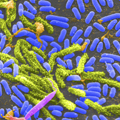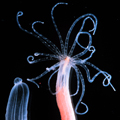
NIGMS supports all research featured in Biomedical Beat. Although only the lead scientists are named, coworkers and other collaborators also contributed to the findings.
Got research news to share? E-mail us at info@nigms.nih.gov.
|
In This Issue...January 21, 2009 |
|||
|
Cool Image: DNA Record Just as paleontologists have fossils, biomedical researchers have DNA to help them study the past. Studying changes as well as similarities in DNA sequences reveals how organisms evolve over time. This issue highlights how the concept of evolution undergirds biomedical research. More... |
Quick Links | ||
|
How We're Different from Chimps Evolutionary changes in our DNA may make people more susceptible to certain diseases chimps do not get. More...
|
Low on Iron A finding in yeast may help explain iron deficiency and diabetes in humans. More...
|
"Bombing" Drug-Resistant Bacteria A naturally occurring genetic "smart bomb" might help slow the spread of antibiotic-resistant bacteria. More... |
Short RNAs Show a Long History Small RNAs were present early in animal evolution and may have contributed to the development of more complex organisms. More... |







